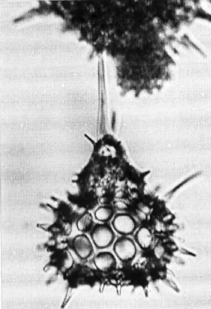 Calocycloma
castum (Haeckel)
Calocycloma
castum (Haeckel) Calocycloma
castum (Haeckel)
Calocycloma
castum (Haeckel)Calocyclas casta Haeckel, 1887, p.1384, pl.73, fig.10
Calocycloma castum (Haeckel), Foreman, 1973, p.434, pl.1, figs.7, 9, 10
Shell generally of two segments, subpyriform. Cephalis subspherical, poreless, or with a very few small pores; occasionally spiny; bearing a cylindro-conical horn. Collar stricture well defined externally and with four collar pores internally. Thorax proximally conical with small circular pores sometimes arranged in vague longitudinal rows, remainder inflated with very large circular to subangular pores, surface generally with large, slender, conical spines at the junctions of the intervening pore bars. Aperture surrounded by a rounded rim, which may be smooth or bear irregularly developed, small, downwardly directed spines or thorns. Some similar early forms with a wider aperture, sometimes with attached fragments of lattice rather than thorns, are not included (Foreman, 1973).
Based on 20 specimens. Length overall, exclusive of horn, 150-220 µm (majority 150-185 µm); greatest width 100-185 µm; greatest diameter of pores 20-37 µm, of aperture 35-75 µm (Foreman, 1973).
Two-segmented, with small subspherical cephalis, and large thorax with its proximal part conical and small-pored, and its dominant distal part inflated and with very large pores. Surface generally spiny (Riedel and Sanfilippo, 1978a).
C. castum is distinguished from C. ampulla (Ehrenberg) (1854), with which it co-occurs, in having larger pores and more distinct change in contour between the conical and inflated parts of the thorax (Sanfilippo et al., 1985).
Subpyriform shell of two segments. Cephalis poreless, occasionally spiny, with a long slender cylindro-conical horn (up to 250 µm). Thorax proximally conical with small irregular pores, distally inflated with very large subcircular pores. The abrupt change in external contour between the proximal and the distal parts of the thorax, at the level where the pores change in size, is not associated with an internal segmental division. Slender spines arise from the junctions of the intervening pore bars. Aperture restricted, surrounded by a rim that is smooth or spiny (Sanfilippo et al., 1985).
C. castum is found between about 30°N and a locality that was at more than 45°S at the time of its deposition (DSDP Site 248), and ranges through most of the early and early middle Eocene. Its morphotypic first appearance is within the Bekoma bidartensis Zone and its morphotypic last appearance is approximately synchronous with the lower limit of the Dictyoprora mongolfieri Zone.